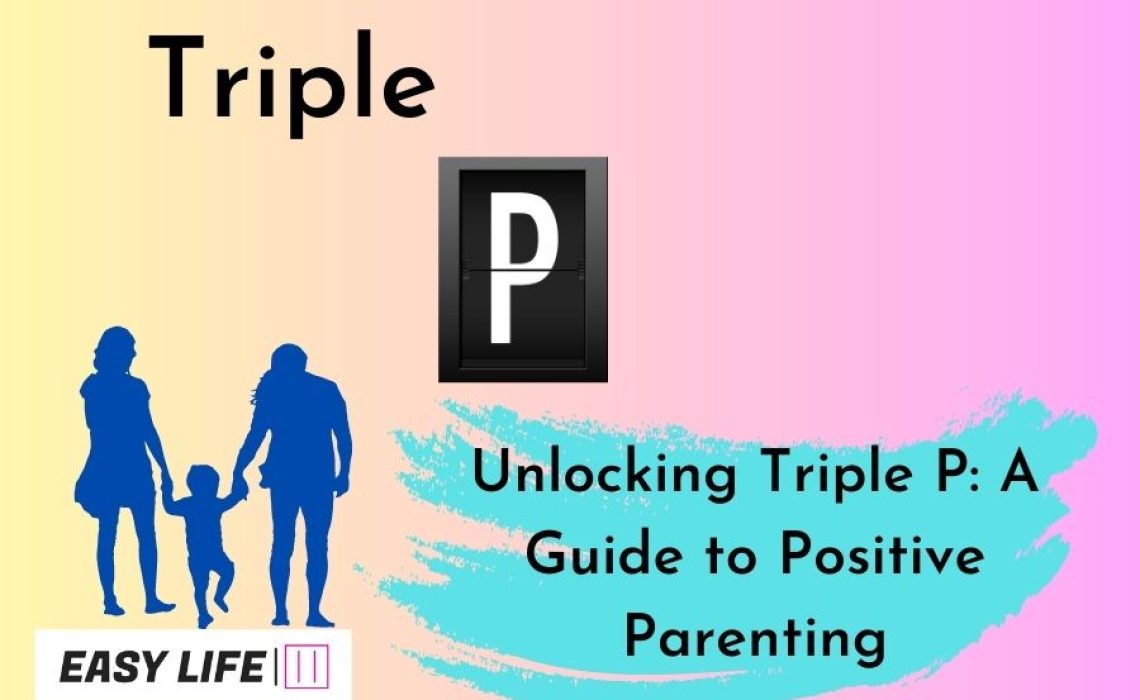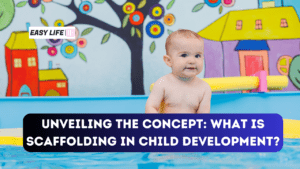Parenting, an immensely rewarding yet challenging journey, is often riddled with doubts and questions about the best strategies and practices to raise happy, healthy, and well-adjusted children. In order to aid parents and caregivers in this essential task, a number of parenting programs have been developed over the years. Among these, one of the most acclaimed and widely implemented is the Triple P – Positive Parenting Program.
Triple P is a multi-level, evidence-based parenting and family support strategy designed to prevent – and treat – behavioural and emotional problems in children and teenagers. Its name, “Triple P,” stands for “Positive Parenting Program,” encapsulating the program’s emphasis on fostering positive, caring relationships between parents and their children.
The program isn’t about telling parents how to raise their children, but rather offering a suite of tools and strategies from which parents can choose to suit their own values, beliefs, and needs. It’s a flexible, practical way of developing skills, strategies, and confidence to handle any parenting situation.
In the following sections, we will delve deeper into the core strategies of the Triple P program, explore the theoretical principles it’s based on, and investigate how it encourages positive parenting. Furthermore, we will review a popular Triple P parenting book, providing insights into its content and its potential value for parents.
Table of Contents
Toggle1. The Core Strategies of Triple P
A. Brief Overview of Strategies
The Triple P program centres around five core principles of positive parenting, which provide a foundation for its strategies:
- Ensuring a safe, engaging environment
- Creating a positive learning environment
- Using assertive discipline
- Having realistic expectations
- Taking care of yourself as a parent
B. Detailed Discussion of Each Strategy
- Ensuring a safe, engaging environment: This principle emphasizes the importance of making the home environment safe and interesting for children. This means minimizing potential safety hazards and providing engaging activities that stimulate a child’s natural curiosity and desire to learn.
- Creating a positive learning environment: This strategy focuses on fostering an environment where children are encouraged to learn and explore. This includes providing positive feedback, encouragement, and recognition when children demonstrate desirable behaviour or make efforts to learn new skills.
- Using assertive discipline: This principle involves setting clear expectations for behaviour, being consistent in enforcing rules and applying appropriate and non-harsh consequences for rule violations. It also includes teaching children problem-solving skills so they can manage their own behaviour.
- Having realistic expectations: This strategy emphasizes understanding and accepting that children have limitations and will make mistakes as part of their learning and development process. It encourages parents to set age-appropriate and individualized expectations for their children.
- Taking care of yourself as a parent: This principle underscores the importance of parents caring for their own physical and emotional health. This can include setting aside time for relaxation and leisure activities, maintaining social contacts, and seeking help when needed.
These strategies don’t act in isolation but rather work synergistically to promote positive behaviour, manage misbehaviour, and improve the parent-child relationship. They also provide parents with the flexibility to tailor the strategies according to their family’s specific needs and circumstances.
2. Theoretical Basis of Triple P
A. The Principles and Theories Triple P is Based On
The Triple P – Positive Parenting Program is grounded in social learning theory, cognitive-behavioural principles, and the principles of developmental psychology.
- Social Learning Theory: This theory posits that people learn from one another, via observation, imitation, and modelling. In the context of Triple P, it informs the understanding of how children learn behaviours from their parents and the environment around them.
- Cognitive-Behavioural Principles: Cognitive-behavioral therapy (CBT) focuses on how our thoughts influence our feelings and behaviours. Triple P uses these principles to help parents understand and modify their own and their children’s behaviours.
- Developmental Psychology: This discipline studies the psychological changes that occur as humans grow and develop. It guides the Triple P’s approach to understanding children’s behaviour and emotional development at different ages and stages.
B. The Scientific Research Supporting Triple P
The Triple P program is evidence-based, which means it has been tested and proven effective through rigorous scientific research. Multiple studies conducted worldwide have shown that Triple P improves children’s behaviour, reduces parents’ stress and depression, and strengthens parent-child relationships. The program is continually refined and updated in response to new research findings to ensure its effectiveness and relevance to diverse families and communities.
3. Understanding Positive Parenting in the Context of Triple P
A. Definition of Positive Parenting
Positive parenting is a method that emphasizes mutual respect and promotes a warm, nurturing relationship between parents and their children. It involves communication, setting clear boundaries and expectations, and using discipline strategies that teach children how to behave appropriately rather than just punishing them for misbehaviour.
B. How Triple P Encourages and Enhances Positive Parenting
The Triple P program provides a practical and helpful framework for implementing positive parenting strategies. It encourages parents to interact positively with their children, to set specific, manageable goals for change, and to adjust their parenting behaviours to achieve these goals.
- Interaction: Triple P guides parents to engage with their children in a positive manner, enhancing the parent-child relationship. This involves listening, showing empathy, and giving positive attention to children when they display desirable behaviours.
- Goal Setting: Triple P assists parents in setting realistic and specific goals for their children’s behaviour and for their own parenting practices. This gives parents a clear sense of direction and helps them focus their efforts effectively.
- Behavioural Change: Through a range of strategies, Triple P encourages parents to develop and consistently apply positive parenting practices. These include using assertive discipline, creating a positive learning environment, and managing personal stress and well-being.
By offering a range of strategies, Triple P empowers parents to select and apply the ones that best suit their family situation and their child’s unique characteristics. This flexibility makes the program applicable to a wide range of families and contexts, thus enhancing its effectiveness and popularity.
4. Review of the Triple P Parenting Book
A. Overview of the Book Content
The Triple P Parenting Book is a comprehensive guide that encapsulates the principles and strategies of the Triple P program. It provides practical advice, real-life examples, and actionable tips for parents to navigate the myriad of parenting challenges.
The organization of the book aligns with the program’s core principles. These include creating a safe, engaging environment, fostering a positive learning environment, employing assertive discipline, setting realistic expectations, and maintaining parental well-being.
B. How the Book Relates to the Triple P Program
The book is designed as a standalone resource, but it is also an excellent complement to the Triple P program. It provides a deeper understanding of the strategies taught in the program and serves as a reference that parents can revisit as their children grow and their parenting challenges evolve.
C. Critical Assessment of the Book’s Value for Parents
The Triple P Parenting Book is a valuable resource for all parents, regardless of whether they are facing specific parenting issues or simply want to enhance their parenting skills. Its strength lies in its clear, easy-to-understand language and its practical, evidence-based advice.
The book reinforces the idea that there is no one-size-fits-all approach to parenting. It encourages parents to adapt the strategies to their unique family situation and to focus on building positive, respectful relationships with their children.
However, like any parenting resource, the book is not a substitute for professional advice when dealing with complex or severe behavioural issues. In such cases, parents are encouraged to seek help from qualified professionals.
5. Is Triple P parenting legit?
Yes, Triple P – Positive Parenting Program is a legitimate and widely recognized parenting program. Its efficacy has been confirmed through numerous scientific studies and its use is widespread in many countries.
The program is based on evidence from research in developmental psychology, clinical psychology, and public health. This research has shown that Triple P can help reduce children’s behaviour problems. And improve parents’ well-being and confidence, and enhance the quality of parent-child relationships.
Various health and educational organizations worldwide recommend Triple P. Healthcare facilities, schools, and community centres use it in a variety of settings, tailoring it to different age groups, from infancy to adolescence, and specific situations like divorce or separation.
The effectiveness of any program or intervention can vary. It largely depends on the consistency and accuracy with which families apply the strategies. It also depends on the family’s specific needs and circumstances, as well as the severity of the issues they are addressing. In cases of complex or severe issues, seeking professional guidance is always a good course of action.
In conclusion, Triple P is a well-regarded, research-backed program that many parents and professionals find to be a valuable tool in promoting positive parenting practices and improving child behaviour.
6. What age do you time out Triple P?
The Triple P – Positive Parenting Program recommends using “time-out” as a discipline strategy for children aged between 2 to 6 years old. But it’s important to keep in mind that the success of the time-out strategy rests more on how it’s used than on how old the child is.
Here are a few key principles for implementing time-out effectively:
- Clear Explanation: Before using time-out, explain to your child what it is and why it’s being used. Make sure they understand that time-out is a consequence of their inappropriate behaviour.
Short Duration: The duration of the time-out should be brief. A general rule is one minute for each year of the child’s age. A time-out for a child of two years old, for instance, would last two minutes. - Consistent Use: Only use time-out when the child exhibits the specific behaviour you’ve identified as inappropriate. Be consistent each time this behaviour occurs.
- Quiet Space: The time-out area should be a quiet, boring place with no distractions. It is not meant to be frightening, but rather a place where the child can relax.
- Immediate Resumption of Activity: Allow the youngster to quickly resume their activity after the time-out has ended. The purpose of a time-out is to prevent a child from doing something wrong repeatedly, not to make the youngster feel horrible for an extended period of time.
Remember that time-out is just one of several options for dealing with your child’s conduct.
Remember that time-out is only one method of dealing with your child’s bad behaviour. The Positive Parenting Program program emphasizes that parents should choose strategies that best suit their parenting style, their child’s temperament, and the specific situation.
Conclusion
A. Summary of Key Points
The Triple P – Positive Parenting Program is a comprehensive, evidence-based approach to parenting that promotes positive, caring relationships between parents and their children. Grounded in social learning theory, cognitive-behavioural principles, and developmental psychology, Triple P provides parents with a suite of tools and strategies to handle a variety of parenting challenges.
The program’s core principles focus on creating a safe, engaging environment for children, fostering a positive learning environment, using assertive discipline, setting realistic expectations, and maintaining parental well-being. These principles align with the broader concept of positive parenting, which emphasizes mutual respect and a nurturing parent-child relationship.
The Triple P Parenting Book serves as a valuable resource for parents, providing practical advice, and real-life examples. And actionable tips in line with the Positive Parenting Program program’s principles.
B. The Impact and Effectiveness of Triple P
The Triple P program’s impact and effectiveness have been confirmed through numerous scientific studies, showing its capacity to improve children’s behaviour, enhance parent-child relationships, and reduce parental stress. Moreover, its flexibility allows parents to tailor the strategies to their unique family circumstances, increasing its applicability and effectiveness.
In conclusion, the Triple P – Positive Parenting Program is a legitimate, research-backed approach that can be a valuable tool for parents as they navigate the rewarding yet challenging journey of raising children. As with any program, the key to success lies in consistent application and adaptation to specific family needs and circumstances.
Resources
Certainly, here are some resources if you’re interested in learning more about the Triple P – Positive Parenting Program:
- Triple P’s Official Website: www.triplep.net – The official website contains a wealth of information about the program. And including the research behind it. The various forms of the program (for different ages and specific issues), and resources for parents and practitioners.
- Sanders, M. R. (1999). Triple P-Positive Parenting Program: Towards an empirically validated multilevel parenting and family support strategy for the prevention of behaviour and emotional problems in children. Clinical Child and Family Psychology Review, 2(2), 71-90. – This academic article by the program’s founder provides an overview of the program and the research supporting its effectiveness.
- Turner, K. M., & Sanders, M. R. (2006). Help when it’s needed first: A controlled evaluation of brief, preventive behavioural family intervention in a primary care setting. Behaviour Therapy, 37(2), 131-142. – This study offers evidence of the effectiveness of Triple P in a primary care setting.
- Sanders, M. R. (2012). Development, evaluation, and multinational dissemination of the Triple P-Positive Parenting Program. Annual Review of Clinical Psychology, 8, 345-379. – This review provides a comprehensive look at the development and dissemination of the Triple P program.
- “Every Parent’s Guide to Raising Healthy, Happy Children: A Parent’s Handbook.” (Book) – This handbook provides a practical guide to the Triple P program, with tips and strategies for parents.
Please note that while I strive to provide accurate information. I recommend visiting the official Triple P website or contacting a certified Triple P provider for the most current and comprehensive information.









